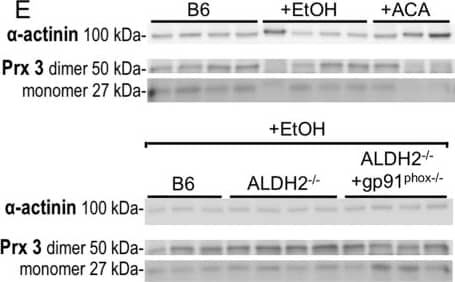Human/Mouse Peroxiredoxin 3 Antibody Summary
Met1-Gln257
Accession # P20108
Applications
Please Note: Optimal dilutions should be determined by each laboratory for each application. General Protocols are available in the Technical Information section on our website.
Scientific Data
 View Larger
View Larger
Detection of Human and Mouse Peroxiredoxin 3 by Western Blot. Western blot shows lysates of TF-1 human erythroleukemic cell line and mouse spleen tissue. PVDF Membrane was probed with 1 µg/mL of Human/Mouse Peroxiredoxin 3 Antigen Affinity-purified Polyclonal Antibody (Catalog # AF6610) followed by HRP-conjugated Anti-Goat IgG Secondary Antibody (Catalog # HAF019). A specific band was detected for Peroxiredoxin 3 at approximately 28 kDa (as indicated). This experiment was conducted under reducing conditions and using Immunoblot Buffer Group 8.
 View Larger
View Larger
Detection of Mouse Peroxiredoxin 3 by Western Blot Pharmacologic inhibition or genetic ablation of NOX reduces mitochondrial superoxide production in isolated CMs cultured in the presence of EtOH and ACA.(A) Scheme depicting incubation and imaging of isolated adult CMs from B6, ALDH2−/− or ALDH2−/−/gp91phox−/− mice with apocynin (300 μM), EtOH (100 μM) or ACA (100 μM). (B) MitoSOX-enhanced fluorescence per CMs. Quantification of 205–931 CMs on 6–12 independent low power fields per group. (C) Representative fluorescence images of CMs loaded with MitoSOX after culture for 18h in control media (leftmost column) in the presence of ACA 100 μM (middle column) and in the presence of ACA (100 μM) together with the NOX inhibitor apocynin (300 μM) rightmost column. (D) Peroxiredoxin 3 ratio monomer/dimer determined by Western blot under non-reducing, denaturing conditions in n = 4–7 independent samples per group. (E) Representative original Western blots. Image collected and cropped by CiteAb from the following publication (https://www.nature.com/articles/srep32554), licensed under a CC-BY license. Not internally tested by R&D Systems.
Reconstitution Calculator
Preparation and Storage
- 12 months from date of receipt, -20 to -70 °C as supplied.
- 1 month, 2 to 8 °C under sterile conditions after reconstitution.
- 6 months, -20 to -70 °C under sterile conditions after reconstitution.
Background: Peroxiredoxin 3
Peroxiredoxin-3 (Prx-3/III; also AOP-1, MER5 and thioredoxin-dependent peroxidase reductase) is a ubiquitous, 22-28 kDa mitochondrial antioxidant enzyme that belongs to the 2-Cys class of the TSA/ahpC family of peroxiredoxins. Prx-3 is known to act as either a homodimer, or a decamer, and scavenge reactive oxygen species generated by oxidative stress. The mouse Prx-3 precursor molecule is 257 amino acids (aa) in length. It contains a cleavable N-terminal 63 aa mitochondrial targeting sequence, plus a 194 aa mature enzyme that shows a thioredoxin domain between aa 64-222. There are two catalytic cysteines, one at Cys109 and another at Cys230 of the precursor. Prx-3 undergoes a phosphorylation at Thr147 that reduces its activity. One potential splice form shows a deletion of Arg149, Lys150 and Arg185. Full-length mouse Prx-3 is 86% and 95% aa identical to human and rat Prx-3, respectively.
Product Datasheets
Citations for Human/Mouse Peroxiredoxin 3 Antibody
R&D Systems personnel manually curate a database that contains references using R&D Systems products. The data collected includes not only links to publications in PubMed, but also provides information about sample types, species, and experimental conditions.
2
Citations: Showing 1 - 2
Filter your results:
Filter by:
-
Electrophiles modulate glutathione reductase activity via alkylation and upregulation of glutathione biosynthesis
Authors: S Jobbagy, DA Vitturi, SR Salvatore, L Turell, MF Pires, E Kansanen, C Batthyany, JR Lancaster, BA Freeman, FJ Schopfer
Redox Biol, 2018-11-22;21(0):101050.
Species: Mouse
Sample Types: Cell Lysates
Applications: Western Blot -
NOX2 amplifies acetaldehyde-mediated cardiomyocyte mitochondrial dysfunction in alcoholic cardiomyopathy
Sci Rep, 2016-09-14;6(0):32554.
Species: Mouse
Sample Types: Tissue Homogenates
Applications: Western Blot
FAQs
No product specific FAQs exist for this product, however you may
View all Antibody FAQsReviews for Human/Mouse Peroxiredoxin 3 Antibody
There are currently no reviews for this product. Be the first to review Human/Mouse Peroxiredoxin 3 Antibody and earn rewards!
Have you used Human/Mouse Peroxiredoxin 3 Antibody?
Submit a review and receive an Amazon gift card.
$25/€18/£15/$25CAN/¥75 Yuan/¥2500 Yen for a review with an image
$10/€7/£6/$10 CAD/¥70 Yuan/¥1110 Yen for a review without an image

